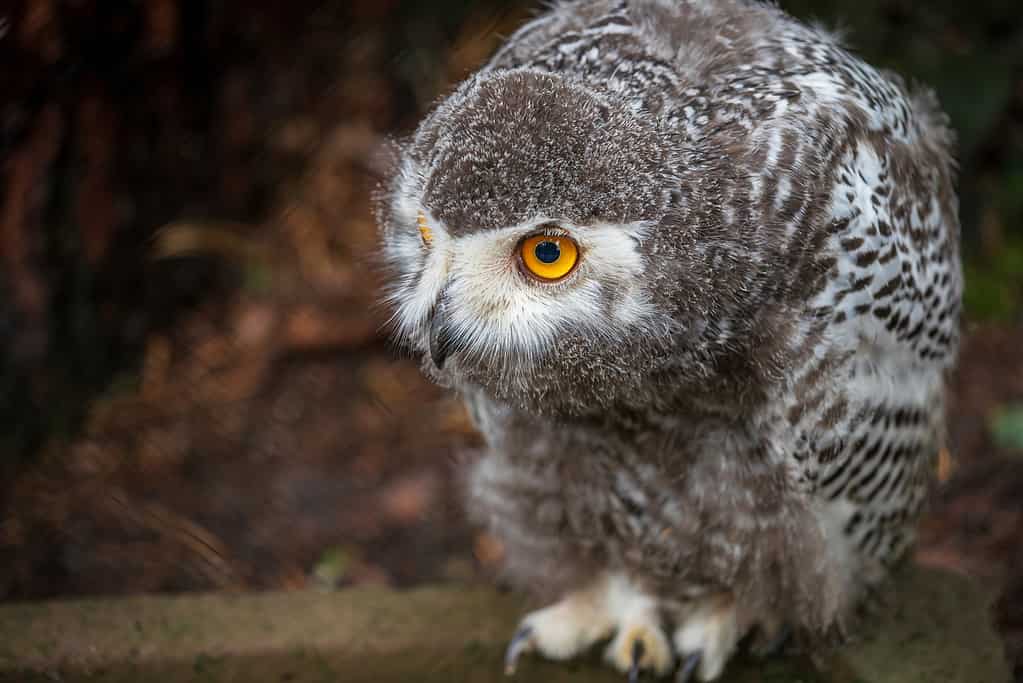
Baby Snowy Owls look much different than their parents.
©Vronja_Photon/iStock via Getty Images
Owls in Pennsylvania are adorable birds to some and odd to others. They’re a diverse animal group with over two hundred species. Some might find it odd that they can rotate their heads up to 270 degrees of motion. This unique ability allows them to compensate for their immobile eyesight. Owls are also famous for their uneven ear placements and their flying patterns. Owls can’t fly straight unless they do short flapping motions.
The owl species come in all different shapes, colors, and sizes making each species much easier to identify. They have some common features. Some of those common features are their large immobile eyes, shark beaks, rounded feathers, and short tails.
Pennsylvania’s geography is composed of many woodlands. As close to sixty percent of the state is forested. The Appalachian, Pocono, and Allegheny mountains also run through Pennsylvania. Thanks to the climate, owls in Pennsylvania can thrive. The Keystone State is known to be home to eight different owl species; some of them are very common and others are very rare. The Pennsylvania Game Commission has several owls listed as endangered species due to how rare they are in the state. Keep reading to learn more about all the owls in Pennsylvania!
What Is The Rarest Owl In Pennsylvania?

A picture of the
Long-eared Owl
©Feng Yu/Shutterstock.com
The Pennsylvania Game Commission states that the Long-eared Owl is one of the rarest bird-breeding species in their state. Its official classification from Pennsylvania’s State Wildlife Action Plan considers them as a “High-Level Concern Species” and their population trends show a decline in the number of Long-eared Owls present. The Asio otus species is a slender owl that appears larger in flight than it actually is due to its long wings. These owls look similar to the great horned owl, but a significant difference between the two is that the Long-eared Owls have streaked bellies rather than barred bellies. Another difference is that the Long-eared Owls’ ears are closer to each other.
Long-eared Owls are usually fifteen inches tall with a forty-inch wingspan and weigh close to eleven ounces. They use their very long ears to hunt for prey at night. The female Long-eared Owls are typically taller than the males by close to four inches. These owls are typically quiet for most of the year with the exception of mating season. Baby Long-eared Owls typically take about thirty days to start flying out of their nests finally.
Where Are Long-Eared Owls At In Pennsylvania?
The Pennsylvania Game Commission said that these owls populate different environments in Pennsylvania. Their prime habitats are woods, wetlands, and fields. Long-eared Owls also live in dense conifer tree groves. These owls do not build their own nests. Instead, they reuse nets from different bird species such as hawks, magpies, crows, and ravens. These owls eat mice and frogs.
What Is The Most Common Owl Species In Pennsylvania?
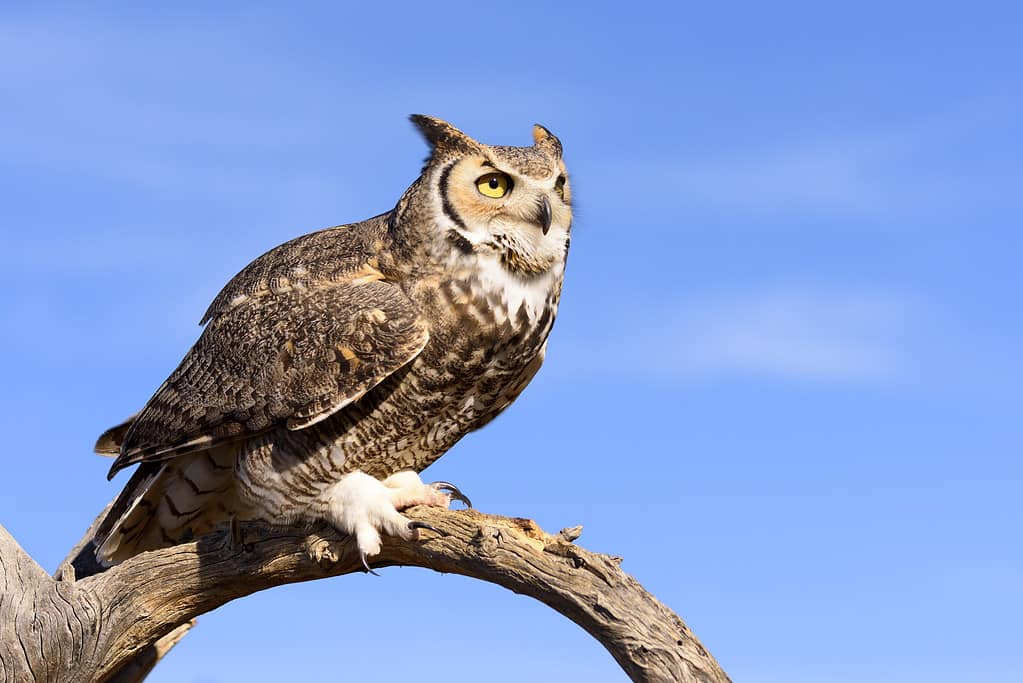
Great Horned Owl with a blue sky background.
©kojihirano/iStock via Getty Images
The Pennsylvania Game Commission recognizes the Great Horned Owl as the most common owl species in their state. These owls are famous for being seen as the tiger of the air. Great Horned Owls have powerful talons that are strong enough to crush the spinal columns of prey larger than themselves. On average, they can weigh up to 3.5 lbs, are 19 to 24 inches in length, and have a huge wingspan that varies between three to five feet. The Great Horned Owls are some of the largest owls in Central and South America, but they do not have the largest wingspans in the owl species.
Great Horned Owls’ feathers are soft brown with greyish-white areas for their breaths and bellies. Their tiny horns are two inches long. These owls have famous “hoot calls” where their booming hoots are said in some sort of Morse code. Great Horned Owls can fly as fast as forty miles per hour. Because of their speed and strong talons, they’re seen as great hunters. The Great Horned Owls also have uneven ears so they can hear their prey at different levels at a better rate than if their ears were symmetrical.
Where Do Great Horned Owls Live In Pennsylvania?
The Great Horned Owls are some of the most widespread owls in the world. They can be seen in nearly every type of environment in the state of Pennsylvania. They live in abandoned squirrel, hawk, and crow nests as well as tree cavities and hollow stumps. Outside of Pennsylvania, they have a high tolerance for different climate conditions. Therefore, they can live in wetlands, forests, and even deserts.
What Are The Other Types Of Owls That Live In Pennsylvania?
The state has many more different types of owls outside of the Great Horned Owls or the Long-eared Owls. Pennsylvania’s forested geography makes it a perfect place for owls to live.
Eastern Screech Owl
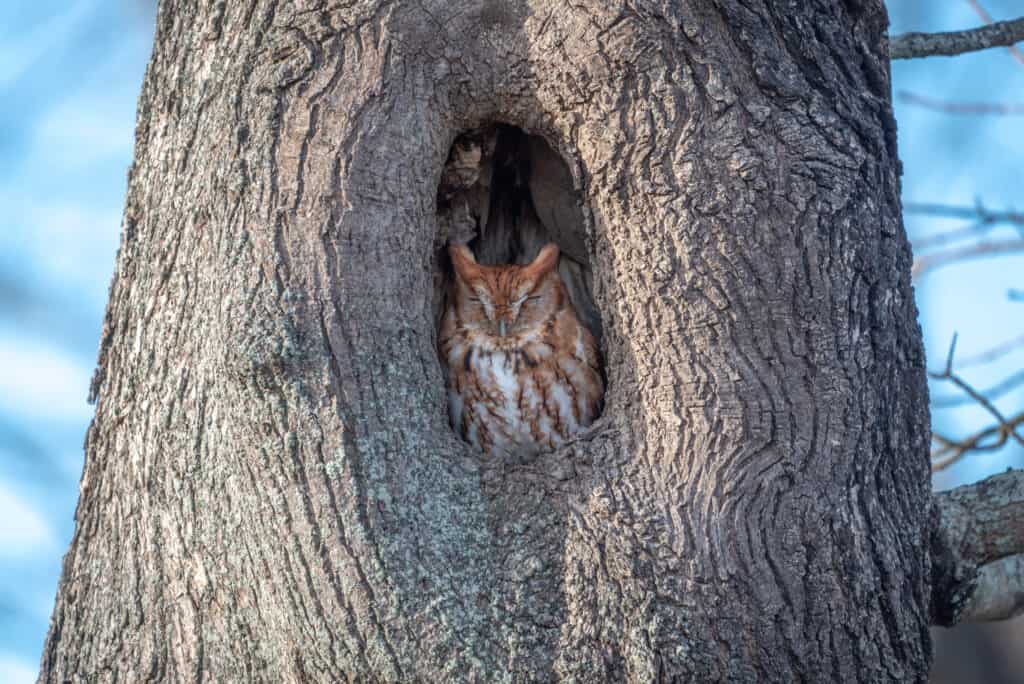
Sleeping Eastern Screech Owl
©Kathryn Bedard/Shutterstock.com
The Eastern Screech Owl is a tiny owl that’s under ten inches long. Their male species can be as tiny as 8.5 inches. Its plumage can appear similar to the color of bark and include grey, red, and white feathers. Thanks to their feather patterns, they can seamlessly disappear into the background to hide from potential predators and their prey. In Pennsylvania, the grey-feathered Eastern Screech Owl is more common than the red-feathered Eastern Screech Owl.
Eastern Screech Owls have their own famous calls which are termed three names: “mournful wail”, “quavering whistle”, or long descending whiny with tremolo, repeated at irregular intervals”, i.e. a (hulululululululululu noise). They nest in tree cavities, like the picture above, or at other birds’ nests and even backyard owl houses. They’re a friendly owl species compared to the other owls in Pennsylvania.
Their diet might be the most vast of any of the other owls in The Keystone State. It involves many small animals and large insects. Some of the insects they eat are grasshoppers, beetles, katydids, and moths. Some of the animals they consume are rabbits, shrews, rats, squirrels, and some birds like blue jays, northern flickers, frogs, and flying squirrels. These owls hunt from above on a branch and swoop down on their prey. They can also swoop down and grab water-based animals in shallow waters like tadpoles.
Where Do Eastern Screech Owls Live In Pennsylvania?
These little owls live in many woodlands, cemeteries, parks, trees in residential areas, riversides, and wetlands. They can also be seen at farms. Throughout the past forty years, the population has gradually reduced in Pennsylvania per the Atlas of Breeding Birds In Pennsylvania. An assumed cause of the reduced population is the West Nile Virus.
Barn Owls
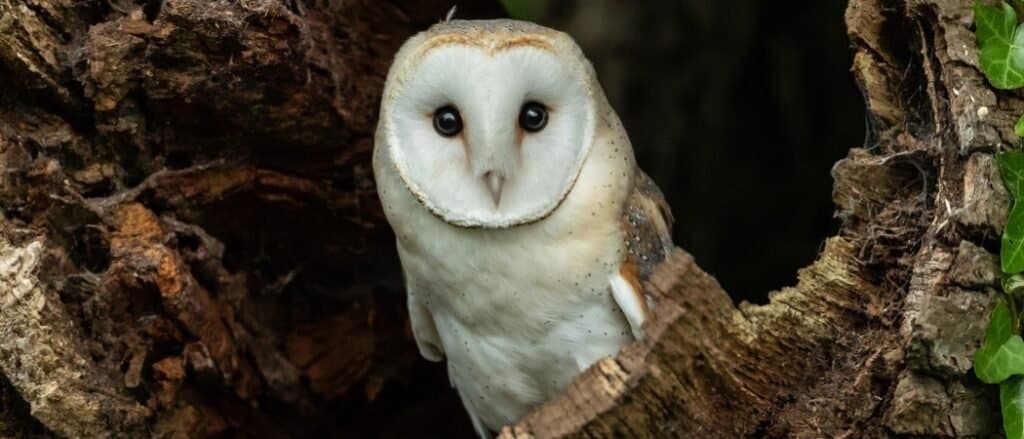
A
Barn Owl
in a hollow tree.
©iStock.com/Alan Walker
These owls are known for their heart-shaped faces. Barn Owls can grow as tall as fourteen to twenty inches with a forty-four-inch wingspan. Sometimes, they’re called monkey-faced owls for their similarities in head shape. Both sexes have white-grayish plumage along with cinnamon-like underbellies. Barn Owls stand out from other owls because they don’t have any horns or have a hooting call like other owls. The Barn Owls have a whistle and a snore that’s easily recognizable rather than having a hooting call. Although they’re like other owls in how they don’t build their own nests, female Barn Owls shred their pellets to make a nest for their eggs. While nesting, mother Barn Owls will bring captured mice to the nest to store them for their new babies.
Where Do Barn Owls Live?
It’s in the name. The Barn Owls love to live in barns. The Pennsylvania Game Commission has been working with private owners to solve the issue of Barn Owls damaging farms and their crops. Barn Owls also live in church towers, hollow trees, marshlands, swamps, silos, ventilation shafts, riversides, and clay embankments. During the night, they hunt in open fields and in neighborhoods. These owls love to eat small rodents, mice, rabbits, insects, and shrews.
Snow Owls

Snowy Owl patiently gazing at the camera.
©Carol Gray/iStock via Getty Images
Snowy Owls are a sight to behold when they usually can be seen. They can be hard to find during winter due to their bright white feathers. This owl species isn’t the friendliest as they tend to be by themselves. Yet, a pair of snowy owls protect each other from predators. Meanwhile, the Snowy Owls are predators themselves. They eat lemmings, rabbits, several birds, and fish. Snowy Owls are even strong enough to take down geese by themselves.
Like the Great Horned Owl, they’re large owls as they can grow to twenty-four inches. These birds can have a wingspan of up to sixty inches! Unlike their nighttime stereotype, this owl species hunt during the daytime as well as the nighttime. When they hunt, they lurk at river banks, hills, silos, hay bales, residential buildings, raised hills, and fence posts. Also, they can be seen hunting at beaches and broad highway corridors.
Where Do Snowy Owls Live At?
These owls can be found in the northernmost part of Pennsylvania in the mountain ranges. Snowy Owls are usually in the northern parts of the United States and even Canada at beaches, mountains, and woods. When they are in Pennsylvania, they’re in open fields, mountains, and forests. Pennsylvania residents can see them in their state as early as November.
They also flock from the Arctic Circle. They have a trend of an irruptive migration. An irruptive migration usually happens when large masses of snowbirds migrate down to the southern states. Many zoologists are still learning what fully causes irruptive migrations every three to five years. One conclusion is that the irruption happens due to food sources being depleted in their northern habitats around winter, so they fly down south to seek food.
Barred Owl

Barred Owl
©FotoRequest/Shutterstock.com
The Barred Owl is one of only two brown-eyed owls in Pennsylvania. The only other brown-eyed owl in Pennsylvania is the Barn Owl. Barred Owls have a large body that can average between sixteen to twenty inches and weigh up to two pounds. They’re loud owls and their hoots sound similar to the phrase “Who cooks for you?” The Barred Owls also have eight total accents in their hoots. Barred Owls have white and brown bodies with a white underbreast. Their wingspan can hit a massive thirty-nine to forty-three inches long.
Even though they have a loud hoot, they’re really silent hunters. They prey on mammals such as house mice, rabbits, reptiles, frogs, insects, and fish. However, their predators include humans, raccoons, great horned owls, and weasels.
Where Do Barred Owls Live In Pennsylvania?
These owls live in upland forest habitats, deep swamps, and mature forests so they can nest in the trees. Pennsylvania Game Commission said they can be seen in the eastern hemlock and conifer woodlands out in The Keystone State. One thing to know about Barred Owls is that they’re permanent residents of wherever they nest. So that means they don’t migrate far out of where they nest their eggs. They are large birds so they need large cavities to nest at like elms and beeches. The Barred Owls often live alone and meet up to mate during mating season and to check up on their children in the nests. Their population has increased everywhere in the United States in the past couple of years. Nowadays, they have three million Barred Owls in the United States.
Short-eared Owls Are An Endangered Species
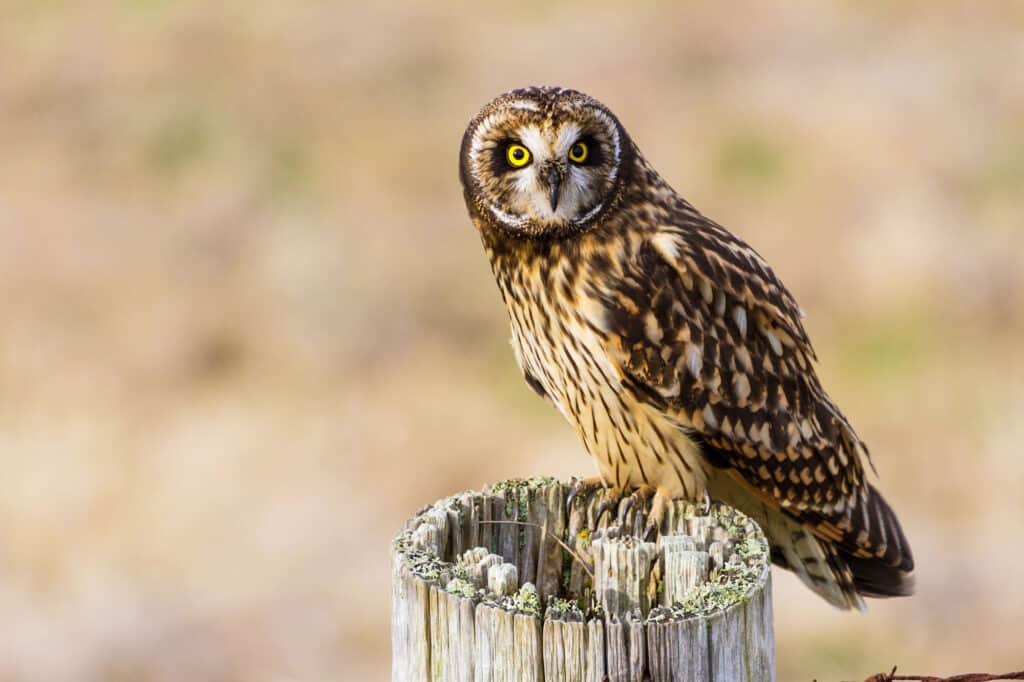
The short-eared owl is vulnerable to diurnal raptors, such as bald eagles, northern goshawks, red-tailed hawks, and snowy owls.
©iStock.com/Devonyu
Short-eared Owls are an endangered species in Pennsylvania. They can grow between thirteen to seventeen inches and have a very long wingspan of forty-two inches. The upper plumage is streaky and buff brown. Their eyes have large black circles as if they’re wearing mascara.
Their ears are very difficult to see due to the brown patterns, but it has excellent hearing that can aid them well in hunting their prey. Unlike the stereotype, the owls hunt actively in the day as much as they’re active in the night. They have a carnivorous diet and mostly eat rodents like weasels and gophers. They also eat bats, rabbits, and shrews. Their main predators are several types of eagles, red-tail hawks, and snowy owls.
Where And When Can Pennsylvania Residents See The Short-eared Owls?
They visit and stay in Pennsylvania during the colder seasons such as fall and winter. These owls mainly visit Pennsylvania for their breeding seasons and migrate back to their northern climates after their breeding season is over. Outside of North America, these owls live in every other continent aside from Antarctica and Australia.
In Pennsylvania, they can be seen in open fields hunting. Short-eared Owls nest in marshy field areas. Other areas the Short-eared Owls can live are meadows, grasslands, prairies, and farms. They prefer to live in areas with low vegetation, however.
Northern Saw-whet Owl
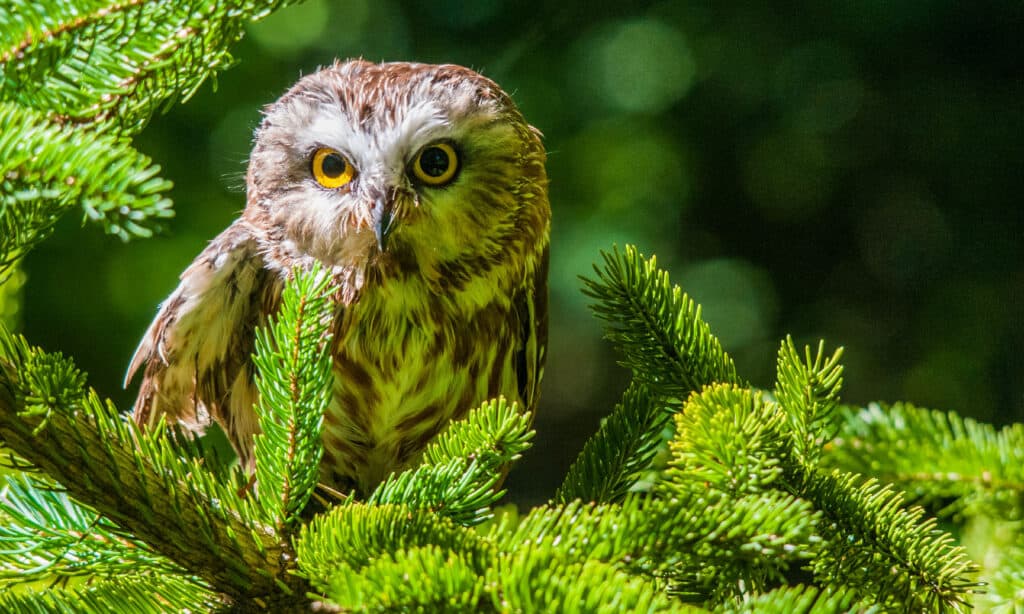
A Northern Saw-whet Owl perched on a tree branch.
©iStock.com/bookguy
This is the tiniest owl species in Pennsylvania. Their bodies are on average seven to eight inches tall. With their large heads, they remind people of larger-than-usual bobbleheads. Its plumage is mostly dark brown with grey and white spots. Northern Saw-whet Owls calls aren’t as much of a hoot compared to the other owls, but they have a mellow, fast whistle that reminds people of a light saw, hence the name “northern saw-whet owl.” Their signature saw whistle is heard often between January and May.
Their primary foods are small mice and rodents. In return, they are preyed upon by larger owls Barred Owls, and Great Horned Owls. The Saw-whet Owls lay low on the ground as a way to take advantage of their small size so they can hide from the much larger predators. Thanks to their large size, it’s hard for people to keep count of their total population, however, migration studies have shown that they also migrate to the Great Lakes.
Where Do Northern Saw-whet Owls Live In Pennsylvania?
These little birdies live in mixed forests around the mountains or on the mountains. They can live in both the northern and southern parts of Pennsylvania. The owls roost in red cedar trees, evergreens, vine tangles, and blueberry bushes. They were once deemed to be a very rare species until advancements in migration studies proved that they’re more widespread than researchers can imagine.
The photo featured at the top of this post is © mlorenz/Shutterstock.com
Thank you for reading! Have some feedback for us? Contact the AZ Animals editorial team.







